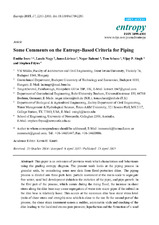| dc.description.abstract | This paper is an extension of previous work which characterises soil behaviours using the grading entropy diagram. The present work looks at the piping process in granular soils, by considering some new data from flood-protection dikes. The piping process is divided into three parts here: particle movement at the micro scale to segregate free water; sand boil development (which is the initiation of the pipe), and pipe growth. In the first part of the process, which occurs during the rising flood, the increase in shear stress along the dike base may cause segregation of water into micro pipes if the subsoil in the dike base is relatively loose. This occurs at the maximum dike base shear stress level (ratio of shear stress and strength) zone which is close to the toe. In the second part of the process, the shear strain increment causes a sudden, asymmetric slide and cracking of the dike leading to the localized excess pore pressure, liquefaction and the formation of a sand boil. In the third part of the process, the soil erosion initiated through the sand boil continues, and the pipe grows. The piping in the Hungarian dikes often occurs in a two-layer system; where the base layer is coarser with higher permeability and the cover layer is finer with lower permeability. The new data presented here show that the soils ejected from the sand boils are generally silty sands and sands, which are prone to both erosion (on the basis of the entropy criterion) and liquefaction. They originate from the cover layer which is basically identical to the soil used in the Dutch backward erosion experiments. | en |


